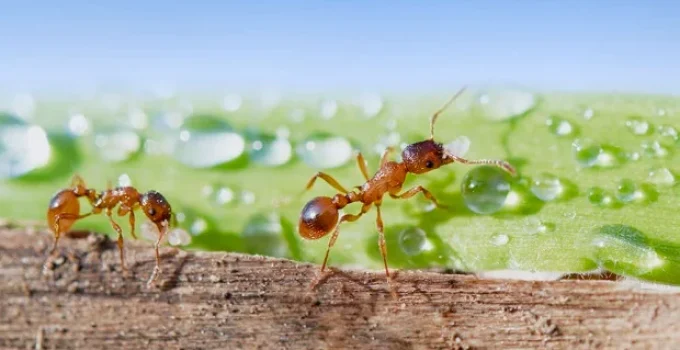Do Ants Have Blood?
Yes, ants do have a fluid that functions like blood—but it’s not the red, iron-rich liquid found in humans. Instead, ants have a clear or pale yellow fluid called hemolymph, which circulates through their bodies and serves many of the same purposes as blood in vertebrates. However, the way it works and the system it flows through are radically different from ours.
🧭 Dive Deeper
- What Is Hemolymph?
- How Does Hemolymph Work in Ants?
- Do Ants Have a Heart or Blood Vessels?
- Why Isn’t Hemolymph Red Like Human Blood?
- Table: Human Blood vs. Ant Hemolymph
- 🎯 Final Thoughts
- 📚 References
What Is Hemolymph?
Hemolymph is the insect equivalent of blood and lymph combined. Found in all insects and many arthropods, this fluid bathes internal organs directly rather than traveling through a closed circulatory system.
Hemolymph performs several vital functions:
- Transports nutrients, hormones, and waste
- Aids in thermoregulation and pressure control
- Contains immune cells to fight infection
- Facilitates molting and wound healing
Unlike vertebrate blood, it doesn’t carry oxygen to tissues—ants use an entirely different system for respiration.
How Does Hemolymph Work in Ants?
Ants have an open circulatory system, meaning hemolymph flows freely through the body cavity (hemocoel) and surrounds internal organs directly. A long, tube-like heart located along the dorsal (top) side of the body pulses rhythmically to push hemolymph from the rear toward the head.
🩺 | Interesting fact: The ant’s heart has a series of valves called ostia that ensure hemolymph flows in the correct direction during each pulse.
This circulation helps deliver nutrients and remove waste, but oxygen exchange is not its job. Ants rely on a system of tiny tubes called tracheae, which deliver oxygen directly to tissues through openings on the body called spiracles.
Do Ants Have a Heart or Blood Vessels?
Ants do have a heart, but not in the human sense. It’s a simple dorsal vessel with muscular contractions that circulate hemolymph. There are no arteries, veins, or capillaries as in vertebrates.
Instead:
- Hemolymph is pushed through body cavities, not enclosed vessels.
- The heart’s peristaltic motion maintains a rhythmic flow, supporting internal regulation.
- Muscular movements from the ant’s legs and body assist circulation passively.
This system is sufficient for small-bodied creatures like ants, whose internal demands are efficiently met without the need for complex vascular structures.
Why Isn’t Hemolymph Red Like Human Blood?
The red color of human blood comes from hemoglobin, a protein rich in iron that binds oxygen. Since ants don’t use hemolymph to transport oxygen, they don’t need hemoglobin. Instead, their hemolymph contains:
- Ions and sugars
- Amino acids and proteins
- Hemocytes (insect immune cells)
- Pigments like melanin (for immune response, not coloration)
This makes ant hemolymph appear clear, pale yellow, or greenish, depending on species and diet.
📊 | Stat: Insects can survive with up to 75% of their hemolymph lost, as long as oxygen delivery through tracheae remains unaffected [1].
Table: Human Blood vs. Ant Hemolymph
| Feature | Human Blood | Ant Hemolymph |
|---|---|---|
| Circulatory System | Closed | Open |
| Primary Fluid Color | Red (due to hemoglobin) | Clear/yellow/greenish |
| Oxygen Transport | Yes (via hemoglobin) | No |
| Contains Immune Cells | Yes (white blood cells) | Yes (hemocytes) |
| Main Function | Oxygen & nutrient transport | Nutrient transport, immune defense |
| Vessels Present | Arteries, veins, capillaries | None |
| Organ Used for Circulation | Four-chambered heart | Dorsal tube-like heart |
🎯 Final Thoughts
So, do ants have blood? They don’t have blood as we know it, but they do have a powerful fluid system that keeps them alive and thriving. Hemolymph may lack the iron-rich red of human blood, but it serves a vital role in nutrition, immunity, and body maintenance. Through an open circulatory system and a unique tracheal network, ants demonstrate yet another way evolution has tailored biology to function with astonishing efficiency.
📚 References
- Chapman, A. D. (1998). Hemolymph and Circulation. In: The Insects: Structure and Function. Cambridge University Press.
- Nation, J. L. (2015). Insect Physiology and Biochemistry. CRC Press.
- Wigglesworth, V. B. (1972). The Principles of Insect Physiology. Springer.
- General Entomology North Carolina State. Insect Circulatory System. https://genent.cals.ncsu.edu/bug-bytes/circulatory-system/
📌Learn More About Ants
- How Do Ants Reproduce?🐜A Deep Dive Into Colony Growth
- Do Ants Have Blood?🐜 The Surprising Truth about Insect Circulation
- Can Ants Smell? 🐜 Exploring the Chemical World of Ant Communication
- Can Ants Swim? 🐜 Exploring the Aquatic Abilities of Earth’s Hardest Workers
- Do Ants Eat Termites? 🐜 The Many Termite Predators
- Do Ants Have Brains? 🐜 Inside the Mind of Nature’s Minature Engineers
- Do Ants Have Muscles? 🐜 Explore What These Muscular Powerhouses Can Do
- Do Ants Sleep? 🐜 Ants Are Supersonic Power Nappers!
- How Long Do Ants Live? 🐜 A Look Into the Lifespan of the Colony
- What Do Ants Eat? 🐜 Inside the Pantry of an Ant Colony
- Are Ants Blind? 🐜How These Tiny Insects See the World
